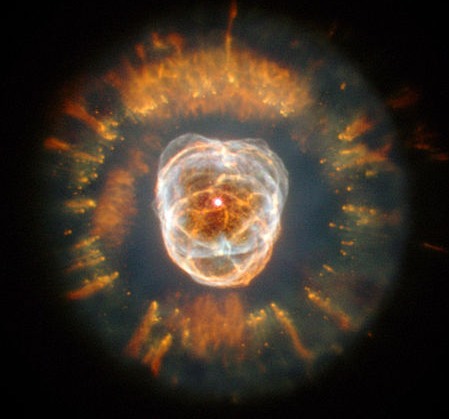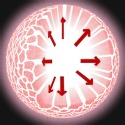Via the Bad Astronomer we get word a supernova has erupted in the nearby spiral galaxy M101, better know to stargazers as the Pinwheel galaxy. Astrophysicists classify it as a Type 1a supernova, the kind that can occur when a big streamer of hydrogen is deposited on the surface of white dwarf, usually by a helpful companion star that has swelled up into a red-giant as shown above. These things are bright! This is easily seen across 25 million light-years, isn’t that cool? If something like that happened nearby, within a few light-years of earth, we’d literally be in a world of hurt. But it’s still small potatoes compared to a Type II supernova, the physics of those events are even more fascinating, and so incredibly violent.
Stars like our sun shine because of hydrogen fusion deep in the center. The proton-proton fusion cycle will keep medium-sized stars like good old Sol shining for billions of years; really massive stars live only a few million years whereas small red dwarfs can shine for a 100 billion or more! But eventually the hydrogen is all fused, and helium ash dominates the core. For the sun this will result in a short cycle of helium fusion, it will swell into a red-giant and cook earth to a cinder. But the helium runs out fast, and that’s the end of the line for sun-sized stars. The core will shrug off its outer layers in a beautiful display like the Eskimo nebula shown below or the Cat’s Eye nebula linked here.
But stars more massive than our sun have a few tricks left! They’ll burn successively heavier elements, helium nuclei combine to produce carbon and oxygen, which in turn will be fused. The process works its way up the periodic table. The star grows hotter and larger at every stage, the crushing gravity pulling the superheated plasma making up the star’s flesh is balanced by continuous fusion reactions at the core creating enormous temperatures, reaching billions of degrees in some cases, pushing back out.
But the star has a big problem. Light elements fuse and liberate energy, heavy elements like uranium split into lighter ones and also produce energy. So there has to be a break even point in the periodic table and that happens to be iron. When iron fuses, it absorbs energy and that’s a stellar dead-end. When the star starts fusing iron, the core no longer produces heat, it’s actually sucking heat up and compressing dramatically. The core shrinks, incredibly fast. This happens so quickly that the star now has a huge open gap between the outer layers and the tiny, shrunken iron bearing core. That gap won’t stay empty for long. Billions of cubic miles of outer stellar materials now falls, accelerated by intense external pressure above and pulled down by the respectable gravity of that dense metal ball below.
The material crashes violently into the core pushing the mixture to enormous temperatures not seen since the first few minutes after the Big Bang, and it’s still chock full of lighter elements like hydrogen and helium along with heavier stuff, which all fuses like crazy in an atomic orgy. More energy is created in this brief process than our sun will release in its entire life, and that energy has to go somewhere. The star blows to bits in a matter of minutes. It’s during those few moments that elements heavier than iron are produced and shot back into the universe in large quantities. All the gold, silver, lead, and uranium on earth were cooked up by supernova explosions.
And the core left behind? Depending on the mass of the star and the type of supernova, it will usually end up either as a rapidly spinning neutron star or a black-hole a few dozen miles in diameter containing the mass of millions of earths. There is growing evidence that planets can either form in the debris field around the tiny core, or survive the cataclysmic event itself, somehow. See yesterday’s post on the hypothetical diamond planet for one such candidate. Which incidentally has given rise to fun discussions like this one at TPM’s twitter feed:
Diamond planet threatens Earth market. Africa sends astronaut (call him Omaba) to destroy planet. US drafts Newt to stop him … Newt wins battle, claims planet for US, marries Diamond Planet Queen.
The actual physics of Type II supernovas are way more complicated than my simplistic and, in all likelihood flawed, review above implies. Large stars still vary in mass and composition. They spin at different rates and may have off axis magnetic fields doing crazy things. Some have binary companions. That all adds up to distinct Type II subclasses, each with their own variations on the internal physics and enormous diversity in the exquisite nebula created. They’re each also critical in every way to our own existence. Not only are we composed in part of substance liberated and/or created by the violence, the shock wave spreading through interstellar space from a Type II supernova can help collapse nearby gas clouds and kick off a cycle of new star formation. Something like this may have been a key factor in the initial creation of our entire solar system beginning about five billion years ago.
That’s a hell of a creation story. If only it were widely taught in Sunday school.






I’m not sure exactly who discovered it, but you can see it with the telescopes available at Slooh.com.
I wrote up a short blog post about the use of the small telescopes and the before and after pics here: http://ogremk5.wordpress.com/2011/08/25/slooh-amateur-astronomy-may-have-discovered-a-supernova-in-progress/
Way to blow someone’s mind: Tell them that about 90% of their body was, at some point, in the stellar core of an ancient star that exploded brightly enough to be seen from another galaxy.
If that doesn’t do anything for them, say it again until it sinks in. Because it’s important.
And every time I read something like this I think: dammit, should have studied cosmology!
There is so much awesome in this post!
Very well written and easy to understand description of the life cycle of a star. Awesome!